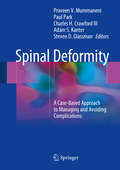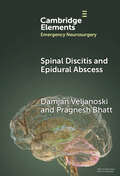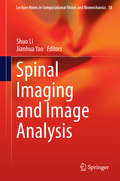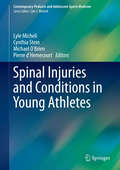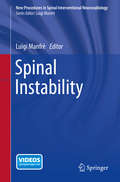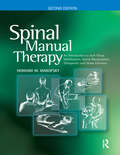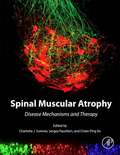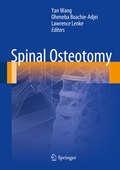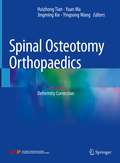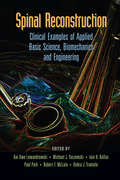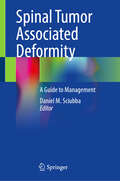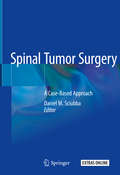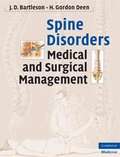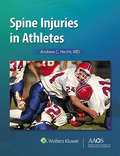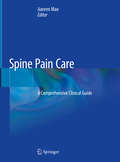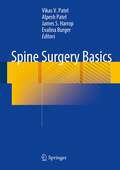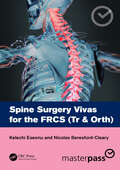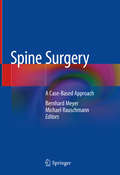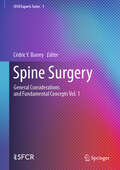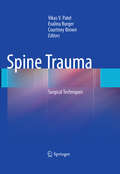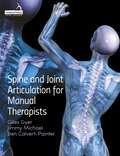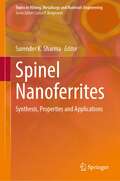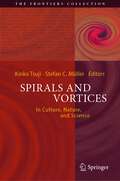- Table View
- List View
Spinal Deformity
by Paul Park Praveen V. Mummaneni Charles H. Crawford III Adam S. Kanter Steven D. GlassmanThe challenge of treating complex spinal deformity often demands innovative solutions and greater skill than the initial surgical intervention; strategic planning is the critical element in successful surgical execution and outcome. Spinal Deformity: A Guide to Surgical Planning and Management, edited and written by the leading experts, is a landmark publication that provides critical information needed to safely plan, stage, and execute operations for the full range of complex spinal deformities. A Virtual Gold Mine of Information This book is an invaluable and practical tool for managing spinal deformities in your practice. Organized into four parts, it begins with a focus on recent advances in spine technology, starting with biomechanics, deformity classification, conservative management, and surgical indications. Subsequent chapters discuss technologic innovations, including spinal biologics, image guidance, and minimally invasive approaches for anterior and posterior spinal fusion. This introductory section is essential reading for the surgeon learning basic technique as well as for the experienced surgeon seeking to refine and enhance skills. The remaining parts focus on state-of-the-art surgical techniques for treating spinal deformity in the cervical spine, the thoracic spine, and the lumbosacral spine. Specific chapters have also been included on managing deformities at the cervicothoracic, thoracolumbar, and lumbosacropelvic junctions. In addition, both open and minimally invasive techniques are described. Organized with a consistent format, each technique chapter includes information on indications, planning and assessment, clinical problem solving, surgical technique, and postoperative care. A Who's Who of Spine Surgery The editors, Drs. Mummaneni, Lenke, and Haid; the part editors, Drs. Benzel, Kuklo, Resnick, and Shaffrey; and the contributors are world-renowned both neurosurgeons and orthopedic surgeons who have extensive experience in treating spinal deformity. Algorithms, Surgical Plans, and Tips and Tricks Aid in the Decision-Making Process Beautifully illustrated with step-by-step surgical technique, this book provides the practical advice, clinical nuances, and learning aids to assist you in the diagnosis and treatment of complex surgical deformities. Numerous imaging modalities are used to demonstrate the preoperative presentation as well as postoperative results. In addition, clinical problem-solving sections with treatment algorithms guide you in selecting the best surgical approach for each patient. Hundreds of case examples demonstrate the excellent results that can be achieved. To enhance the learning experience, an accompanying DVD with operative video is included.
Spinal Discitis and Epidural Abscess (Elements in Emergency Neurosurgery)
by Pragnesh Bhatt Damjan VeljanoskiSpinal infections (SIs) are rare conditions affecting the intervertebral disc, vertebral body and/or adjacent spinal tissues. The lumbar region is most commonly involved, followed by the thoracic and cervical regions. Patients present with varied, non-specific clinical features leading to diagnostic and treatment delays. Clinicians need to have a low threshold to suspect SI. In this Element, two real-life cases of patients with SIs will be presented first. Core knowledge will be reviewed next, followed by diagnostic pitfalls and clinical pearls. Finally, the 'typical' clinical workflow for a patient with SI will be presented and the various treatment options will be explored.
Spinal Epidural Balloon Decompression and Adhesiolysis
by Jin Woo ShinThis book introduces a new medical device, the ZiNeu catheter, and explains its use for the non-surgical interventional treatment of degenerative spinal disease, including spinal stenosis. In particular, the device can directly alleviate stenosis of the intervertebral foramen or central canal and perineural adhesions, resulting in reductions in back pain, leg pain, and neurogenic claudication. The ZiNeu device was invented by the author and the JUVENUI company. It now has CE certification and is exportable to Europe. The book opens by explaining the concepts of epidural balloon decompression and adhesiolysis and outlining the types and features of the ZiNeu catheter. The full range of procedures using the ZiNeu series, ZiNeuF series, and the ZiNeuF03 catheter is then described and illustrated, and guidance provided on key aspects of decision making and post-procedure management. The book will be of interest to all specialists in pain management.
Spinal Imaging and Image Analysis
by Jianhua Yao Shuo LiThis book is instrumental to building a bridge between scientists and clinicians in the field of spine imaging by introducing state-of-the-art computational methods in the context of clinical applications. Spine imaging via computed tomography, magnetic resonance imaging, and other radiologic imaging modalities, is essential for noninvasively visualizing and assessing spinal pathology. Computational methods support and enhance the physician's ability to utilize these imaging techniques for diagnosis, non-invasive treatment, and intervention in clinical practice. Chapters cover a broad range of topics encompassing radiological imaging modalities, clinical imaging applications for common spine diseases, image processing, computer-aided diagnosis, quantitative analysis, data reconstruction and visualization, statistical modeling, image-guided spine intervention, and robotic surgery. This volume serves a broad audience as contributions were written by both clinicians and researchers, which reflects the intended readership as well, being a potentially comprehensive book for all spine related clinicians, technicians, scientists, and graduate students.
Spinal Injuries and Conditions in Young Athletes
by Michael O'Brien Lyle Micheli Cynthia Stein Pierre D'HemecourtSpinal Injuries and Conditions in Young Athletes provides a comprehensive, in-depth review of the mechanisms and management of back injuries and problems occurring in this ever-growing and active population. Led by Dr. Lyle Micheli and his co-editors, an award-winning group of orthopedists discusses and explores common adolescent spine injuries and procedures, in addition to breakthroughs in gene therapy, tissue engineering, and complex operations. As spine surgery is among the most complex and challenging procedures performed in orthopedics, special considerations and procedures are required in pediatric populations. Since many corrective surgeries run the risk of arthritis later in life, particular efforts must be made in young populations to prevent future injury in a child's adolescence and young adulthood while maximizing return-to-play potential. Chapters cover acute spinal injuries, concussions, overuse injuries, spinal malformations, tumors, infections and inflammatory diseases across the range of athletics, including swimming and combat sports. Spinal Injuries and Conditions in Young Athletes provides an immeasurable guide for back surgery in pediatric populations and will be a go-to resource for practitioners and residents in pediatric orthopedics and sports medicine.
Spinal Instability (New Procedures In Spinal Interventional Neuroradiology Ser.)
by Luigi ManfrèThis easy-to-consult guide describes new minimally invasive procedures for the treatment of spinal instability that are accompanied by fewer complications and side-effects, reduce the risks of anesthesia, and lower costs. Clear accounts of a range of CT, X-ray, and MRI guided techniques are provided, including radiofrequency ablation in facet syndrome, cervical spine fusion, posterior and anterior lumbar spine fusion, and lumbosacral fusion. A brief but comprehensive introduction is included on biomechanics, relevant clinical syndromes, and diagnostic imaging. Like other books in the Springer series New Procedures in Spinal Interventional Neuroradiology, this practice-oriented volume will fill a significant gap in the literature and meet the need expressed by a large number of specialists (interventional neuroradiologists and radiologists, neurosurgeons, and orthopedists) for a topical and handy guide that specifically illustrates the presently available materials and methods.
Spinal Manual Therapy: An Introduction to Soft Tissue Mobilization, Spinal Manipulation, Therapeutic and Home Exercises
by Howard W. MakofskySpinal Manual Therapy: An Introduction to Soft Tissue Mobilization, Spinal Manipulation, Therapeutic and Home Exercises, Second Edition is an easy-to-follow manual of clinical techniques for the spine, pelvis, and temporomandibular joint. The text provides "tools" rather than "recipes" and immerses the reader in the process of "thinking as a manual therapist", rather than functioning as a technician. The clinical utility of this revised second edition combines the art and science of present day spinal manual therapy.The focus of Spinal Manual Therapy, Second Edition is to provide clinically useful treatment techniques, while being mindful of the scientific literature related to the practice of spinal manual therapy. It is an ideal resource for all those interested in grasping the basics of spinal manual therapy and transferring that knowledge into practice within a clinical environment.The hands-on approach taken by Dr. Howard W. Makofsky makes this new edition the go-to textbook for spinal manual therapy.New to the Second Edition: New pictures of examination and treatment techniques with captions Additional case studies New evidence supporting spinal manual therapy Updated references throughout the text This unique textbook has a plethora of clinical techniques, including the rationale for each of their use. With over 300 figures, illustrations, and photographs for each examination/treatment technique for various regions of the body, students and clinicians learning manual therapy will benefit greatly from Spinal Manual Therapy, Second Edition.Inside you’ll find: Evaluation Soft tissue techniques Manipulative procedures Specific exercises Clinical problem solving Spinal Manual Therapy, Second Edition mirrors a course on the introduction to spinal manual therapy and will be welcomed into physical therapy curriculums, as well as appreciated by clinicians when entering clinical practice.
Spinal Muscular Atrophy: Disease Mechanisms And Therapy
by Charlotte J. Sumner Sergey Paushkin Chien-Ping KoSpinal Muscular Atrophy: Disease Mechanisms and Therapy provides the latest information on a condition that is characterized by motoneuron loss and muscle atrophy, and is the leading genetic cause of infant mortality. Since the identification of the gene responsible for SMA in 1995, there have been important advances in the basic understanding of disease mechanisms, and in therapeutic development. This book provides a comprehensive accounting of recent advances in basic and clinical research that covers SMA clinical features and standards of care, multifaceted aspects of SMN protein functions and SMA disease pathology, various animal models, and biomarkers, as well as current therapeutic development.
Spinal Osteotomy
by Yan Wang Oheneba Boachie-Adjei Lawrence LenkeSpinal osteotomy techniques have been dramatically applied as a standard method for severe and rigid spinal deformity. Although clinical results indicate that patients who undergo osteotomy procedures typically experience well deformity correction and ameliorate the clinical appearance, aggressive peri-operative risks and follow-up complications are not rare. More meticulous and standard indication selection, osteotomy plan design and complication prevention strategy and outcome evaluation are critically needed for surgeon majored in spine deformity. The book Spinal Osteotomy is divided into sections that focus on principles of spinal osteotomy, technical and case illustration and outcomes and complications as well as computer navigation and other latest techniques. Each section is heavily illustrated and clearly written for ease of understanding. Orthopedic surgeons, neurosurgeon residents and fellows who want to focus on spinal deformity correction will find this instructive and invaluable.
Spinal Osteotomy Orthopaedics: Deformity Correction
by Huizhong Tian Yuan Ma Jingming Xie Yingsong WangSpinal Osteotomy Orthopaedics is a monograph of introducing osteotomy for spinal deformity correction surgery. Its content is prominent and comprehensive. The unique arrangement with the combination of picture and text shows its concise, intuitive and vivid. It is a monograph for the needs of current clinical practice with quite reference value and teaching significance. The publication of Spinal Osteotomy Orthopaedics expands the scope of application of osteotomy and the combined treatment with osteotomy and internal fixation. It solved the difficult problems only by simple instruments in the past and made the spinal osteotomy further recognized by spinal surgeons in clinical application. Spinal Osteotomy Orthopaedics is composed of 13 chapters, including: History of the Development of Spinal Osteotomy, Application of Tian's Spinal Osteotomes, Transverse Laminectomy for Ankylosing Spondylitis Kyphosis, V-shape Laminectomy for Ankylosing Kyphosis, Pedicle Subtraction Osteotomy for Ankylosing Kyphosis Deformity, Vertebral Column Resection for Ankylosing Spondylitis Kyphosis, Non-apex Osteotomy for ASK, Apex Osteotomy for AS Kyphosis, Spinal Osteotomy for Congenital Angular Kyphosis, Hemivertebra Osteotomy, Osteotomy for Tuberculosis Angular Kyphosis, Posterior Vertebral Column Resection (PVCR) Correction for Severe Rigid Spinal Deformity, Osteotomy for Traumatic Spinal Deformity. They are various surgical methods of spinal osteotomy with Tian’s Osteotomes, and also described in detail by pictures and text. The feature of this book is to illustrate the method of surgical operation to achieve the purpose of enabling beginners to quickly grasp the surgical skills. A good book is a set of handy tools dedicated to the reader. We believed that readers will benefit from it and improve the ability and application level of spinal osteotomy and surgery.
Spinal Reconstruction: Clinical Examples of Applied Basic Science, Biomechanics and Engineering
by Paul Park Kai-Uwe Lewandrowski Robert F. McLain Debra J. Trantolo Michael J. Yaszemski Iain H. KalfasWith an ever-expanding array of biomaterials and implant devices appearing in the field, Spinal Reconstruction: Clinical Examples of Applied Basic Science, Biomechanics and Engineering helps surgeons assess and utilize the latest technologies to improve the reconstruction of the spine and enhance the reconstitution of diseased spinal segments. With
Spinal Tumor Associated Deformity: A Guide to Management
by Daniel M. SciubbaThere are numerous texts on the management of spinal deformities and a number texts on spinal tumor management, but to this point each has been considered separately, leaving providers and learners challenged since they need to study both fields to adequately treat patients. Considering spinal deformity often occurs with the initial presentation of spinal tumors (especially in pediatrics and syndromic tumor states) and also commonly occurs after surgery or radiation or with tumor progression, a text on this subject is timely. Providers who study deformity miss out on these conditions, and providers who study tumors often do not understand the alignment issues when seeking tumor control. Bringing together the latest techniques and management strategies, this book bridges that gap to provide a comprehensive approach to these two related subjects, divided into chapters covering deformities associated with primary tumors, metastatic tumors and iatrogenic deformities as the result of spine tumor treatment. Specific topics such as neurofibromatosis, osteoid osteoma, kyphosis and scoliosis, and spondylolisthesis are presented, along with chin-on-chest deformity, flat-back deformity and pathological fractures as a result of treatment. Offering a unique perspective combining spinal deformity and spine tumor into a cohesive treatment paradigm, Spinal Tumor Associated Deformity is a terrific resource for orthopedic and spine surgeons, neurosurgeons, and all practitioners treating these patients.
Spinal Tumor Surgery: A Case-based Approach
by Daniel M. SciubbaThis practical, step-wise text covers the surgical approaches, resection strategies and reconstruction techniques used for each type of presenting tumor of the spine. Demonstrating the variety of anterior, posterior and intradural approaches and stabilization techniques, and spanning from pathologies of the craniocervical region to sacral and intradural pathologies, each chapter is generously illustrated with figures, radiographs and intraoperative photos. The chapters themselves follow a consistent and user-friendly format: the anatomy and biomechanics of a specific region, patient evaluation, essential oncologic principles, the decision-making process, and technical steps of surgery. A representative case illustration is provided at the conclusion of each chapter, exemplifying pertinent concepts described. Additionally, video segments accompany selected chapters, providing real-time illustration of surgical techniques. <p><p> Technical and in-depth, yet highly accessible, Spinal Tumor Surgery: A Case-Based Approach is an essential resource for orthopedic spine surgeons, neurosurgeons, and surgical oncologists operating on tumors of the spine.
Spine Disorders: Medical and Surgical Management
by J. D. Bartleson H. Gordon DeenAn essential, one-stop reference guide to the evaluation and treatment of patients with cervical, thoracic and lumbar spine disease. Based on a course taught by these highly respected authors at the American Academy of Neurology's Annual Meeting, this volume gives concise descriptions of the anatomy of spine conditions; neurologic and physical findings; advice on diagnostic tests and when to order them; and medical and surgical treatment options. Commonly performed spinal procedures are also described, including the rapidly changing field of minimally invasive surgery. Pitfalls of evaluating and treating spine patients are highlighted, along with advice on how to approach the patient who does not improve or worsens after spine surgery. Spine Disorders: Medical and Surgical Management is an essential purchase for all practitioners in this field.
Spine Injuries in Athletes
by Andrew HechtNavigate the unique clinical issues involved in treating athletes who have spinal injuries. A team of peerless authorities in sports medicine share their unparalleled expertise in Spine Injuries in Athletes, published in partnership with the AAOS. This unique and practical clinical reference culls today’s best approaches for managing these injuries, optimizing function, and ensuring quick but safe return to play whenever possible.
Spine Pain Care: A Comprehensive Clinical Guide
by Jianren MaoThis multi-faceted book provides readers with comprehensive guidance to spine pain care. Unique in structure, the contents integrate various specialties involved in spine pain care, thereby bringing in new prospective and expanding readership. This six part reference begins with a review on the epidemiology and economic impacts that present clinical and financial challenges for spine pain care. Part two then brings the reader into a review of the anatomy, pathophysiology, and etiology of spine pain. Subsequent parts then dive into clinical evaluation tactics, unique disease conditions and treatment options. Finally, the book closes with two chapters discussing the challenges of spine pain medicine and the potential future directions of the field. Written by experts in their respective fields, Spine Pain Care - A Comprehensive Clinical Guide is a first-of-its-kind, barrier breaking work designed for all professionals involved in spine pain care, including physicians and nurses, as well as medical students, residents and fellows as a supplementary educational material.
Spine Surgery Basics
by Evalina Burger Vikas V. Patel Alpesh Patel James S. HarropSpine surgery has increasingly become a surgical field of its own, with a distinct body of knowledge. This easy-to-use book, written by acknowledged experts, is designed to meet the practical needs of the novice and the busy resident by providing essential information on spine pathology, diagnostic evaluation, surgical procedures, and other treatments. After an opening general section, degenerative spinal disease, pediatric spine conditions, spine trauma, spine tumors, infections, inflammatory disorders, and metabolic conditions are all discussed in more depth. Alongside description and evaluation of surgical options, important background information is included on pathology, presentation, diagnosis, and nonsurgical treatments. Potential complications of surgery are also carefully considered. Spine Surgery Basics will be an invaluable aid for all who are embarking on a career in spinal surgery or require a ready reference that can be consulted during everyday practice.
Spine Surgery Vivas for the FRCS (Tr & Orth)
by Kelechi Eseonu Nicolas Beresford-ClearyUp to date and evidence-based answers to a wide range of spinal surgical questions that could be asked in the FRCS (Tr & Orth) Viva exam. Using a clear, case-based structure key points emphasise the core information that will improve the performance of every surgical in training. Sections cover all the key areas of Trauma, Degenerative spinal pathology, Spinal cord injury, Spinal deformity, Primary bone tumours, Metastatic disease, Paediatric spinal surgery, Basic sciences, and other topics. Suitable for use by trainees at all levels in orthopaedic surgery and neurosurgery, both in the UK and internationally, and those with an interest in spinal surgery.
Spine Surgery: A Case-Based Approach
by Bernhard Meyer Michael RauschmannThis book covers the content of European postgraduate spine surgery courses, using a case-based approach. It describes a stepwise solution to a real-world clinical problem and compares this with the best available evidence. It then provides suggestions on how to bridge the gap (if there is one) between standard of care and evidence-based medicine. Spine Surgery: A Case-Based Approach is aimed at postgraduate students of spine surgery (both trainee neurosurgeons and trainee orthopedic surgeons), and is also of interest to medical students.
Spine Surgery: General Considerations and Fundamental Concepts Vol. 1 (SFCR Experts Series #1)
by Cédric Y. BarreyThe "SFCR Experts Series" represent a book series under the aegis of the French Spine Surgery Society (SFCR) and dedicated to the spine surgery. The aim of this first volume is to bring together all the fundamental concepts of spinal surgery, thus offering the spine surgeon an up-to-date overview of this field. To understand the present and anticipate the future, it is essential to know the past. The volume will therefore begin with the history of spinal surgery, describing the most significant milestones of this discipline. The present of spinal surgery will then be discussed, through the epidemiology of spinal practice and today's spinal pathologies. The fundamentals, including surgical anatomy, biomechanics, spinal instrumentation and biomaterials, the biology of bone fusion and bone substitutes, injuries and regeneration of the spinal cord, represent 'the heart' of the book and will subsequently be represented and illustrated within the pages by renowned experts. The economic environment is important for spinal surgery and the place and challenges of the spinal market will also be discussed. Finally, the section on data management, artificial intelligence, innovations and emerging technologies will provide the reader with perspectives and the future of spinal surgery. This first “SFCR Experts Series” volume will surely be greatly appreciated by neurosurgeons and orthopedists as an important contribution to the current knowledge of spine surgery.
Spine Trauma
by Courtney W. Brown Evalina Burger Vikas V. PatelSpinal surgeons treat spinal trauma patients on a regular basis in their hospital emergency rooms. This well-illustrated, hands-on guide to the many surgical techniques required in these situations provides a solid basis for the management of spinal trauma.
Spine and Joint Articulation for Manual Therapists
by G. Gyer J. Michael B. CalvertThe book focuses on the practical application of articulation and mobilisation techniques with clear explanations and visual support of the techniques. Techniques are described for all body regions. Most other books for therapists include only one chapter on these important techniques.This book covers a variety of best practise techniques for all areas of the body. Examples are given to show how to adapt the techniques with the patient in different positions. It also addresses the use of these techniques on children, the elderly and pregnant women.The mechanisms of each technique are explained with reference to the related anatomy and physiology. Information is also given to help the therapist use the techniques safely (for both themselves and their patients) by adapting their own stance and posture to get maximum effect with minimum effort.
Spinel Nanoferrites: Synthesis, Properties and Applications (Topics in Mining, Metallurgy and Materials Engineering)
by Surender K. SharmaThis book highlights the complexity of spinel nanoferrites, their synthesis, physio-chemical properties and prospective applications in the area of advanced electronics, microwave devices, biotechnology as well as biomedical sciences. It presents an overview of spinel nanoferrites: synthesis, properties and applications for a wide audience: from beginners and graduate-level students up to advanced specialists in both academic and industrial sectors. There are 15 chapters organized into four main sections. The first section of the book introduces the readers to spinel ferrites and their applications in advanced electronics industry including microwave devices, whereas the second section mainly focus on the synthesis strategy and their physio-chemical properties. The last sections of the book highlight the importance of this class of nanomaterials in the field of biotechnology and biomedical sector with a special chapter on water purification.
Spirals and Vortices: In Culture, Nature, and Science (The Frontiers Collection)
by Stefan C. Müller Kinko TsujiThis richly illustrated book explores the fascinating and ubiquitous occurrence of spirals and vortices in human culture and in nature. Spiral forms have been used as elements in the arts for thousands of years, whereas their role in nature and science – from DNA and sea shells to galaxies – is still a topic of investigation in numerous fields. Following an introduction to the cultural history of spiral forms, the book presents contributions from leading experts, who describe the origins, mechanisms and dynamics of spirals and vortices in their special fields. As a whole the book provides a valuable source of information, while also taking the reader on an aesthetic and scientific journey through the world of spiral forms.
Spirit Catches You and You Fall Down: A Hmong Child, Her American Doctors, and the Collision of Two Cultures (FSG Classics)
by Anne FadimanWith a new Afterword from the author…Winner of the National Book Critics Circle Award for Nonfiction. <p><p> This book explores the clash between a small county hospital in California and a refugee family from Laos over the care of Lia Lee, a Hmong child diagnosed with severe epilepsy. <p><p> Lia's parents and her doctors both wanted what was best for Lia, but the lack of understanding between them led to tragedy. Winner of the National Book Critics Circle Award for Nonfiction, the Los Angeles Times Book Prize for Current Interest, and the Salon Book Award, Anne Fadiman's compassionate account of this cultural impasse is literary journalism at its finest.
